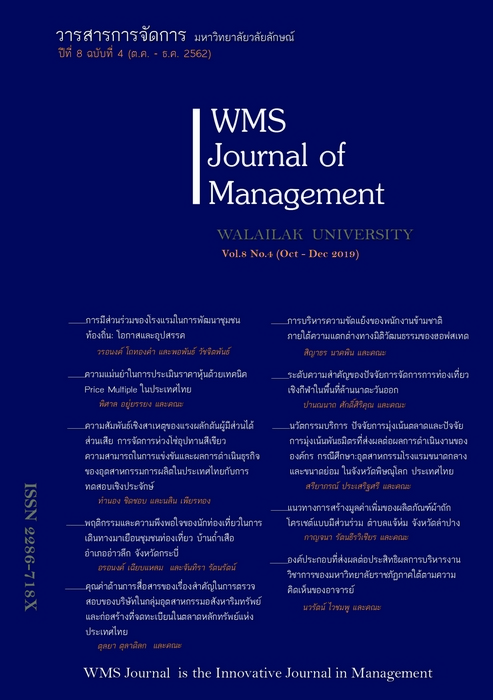Tourist Behavior and Satisfaction on Trips to Ban Thamsua Tourism Community, Krabi Province
Main Article Content
Abstract
This study was conducted with the objective of studying tourist behaviors, motivation and level of satisfaction in visiting the Ban Tham Sua tourism community in addition to recommending guidelines for the management of tourism resources in line with the behaviors and satisfaction of tourists. Quantitative data were collected by using questionnaires to survey 400 Thai tourist subjects, and the data were analyzed by using descriptive statistics. According to the findings, most of the tourists were first-time visitors on trips as observation groups and training/meeting/seminar groups. Most of them had learned about tourism information from their work units or facilities. During visits, the tourists visited and studied community learning bases. Most of the tourists were motivated to travel and tour by resting and relaxing their body and mind at tourist sites. With regard to tourists’ perception of the community, tourists were found to have truly perceived that the communities have attractive scenery and ecosystems.
They had high overall satisfaction toward the community with the highest satisfaction in the scenery and nature of tourist sites. Most of the tourists wanted to revisit the tourist sites in the future. Therefore, tourism resource management was focused on maintaining original nature without making changes, arranging tourism activities to promote learning, and controlling tourist numbers as suitable for tourism activities in order to maintain resource sustainability in the future.
Article Details
References
Cheablam, O., Shrestha, R. P., & Emphandhu, D. (2013). ¬-Does Coral Bleaching Impact Tourists’ Revisitation? A case of Mu Ko Surin Marine National Park, Thailand¬¬¬¬¬¬. Journal of Food, Agriculture & Environment, 11(3-4), 2648-2654.
Cochran, W.G. (1977). Sampling Techniques. 3rd (ed.) New York: John Wiley and Sons.
Designated Areas for Sustainable Tourism Administration. (2018). kānthō̜ngthīeo dōi chumchon [Community-Based Tourism]. Retrieved from http://www.dasta.or.th/
Jittungwattana, B. (2005). kānphatthanā kānthō̜ngthīeo yāng yangyư̄n [Sustainable tourism development]. Bangkok, Thailand.
Kanjanaprom, S. (2012). khwāmphưngphō̜čhai khō̜ng nakthō̜ngthīeo thī mī tō̜ kānthō̜ngthīeo chœ̄ng Niwēt thāng thalē ko̜ʻā dang čhangwat satūn [Tourists' Satisfaction toward Marine Ecotourism in Adang Island, Satun Province]. (Master’s Thesis, Srinakharinwirot University, Thailand).
Keereephet, S., Thumathiwat, D., & Mankeb, P. (2018). Thai Tourists’ Satisfaction toward Ecotourism Management of Kiriwong Community, Lan Ska District, Nakhon Si Thammarat Province. Kingmongkut’s Agricultural Journal, 36 (1), 87-98.
Khamkhom, A. (2003). kānhai bō̜rikān sinchư̄a khō̜ng thanākhān ʻākhān songkhro̜ : sưksā čhāk khwāmkhithen khō̜ng phūchai bō̜rikān fāi kitčhakān sākhā krungthēp læ parimonthon [Providing loans of Government Housing Bank: Study of user feedback services affairs Bangkok and vicinity]. (Master’s Thesis, Kasetsart Universty, Thailand).
Ministry of Tourism & Sports. (2019). rabop sathiti kānthō̜ngthīeo khō̜ng prathēt Thai [Tourism Statistics System of Thailand]. Retrieved from https://www.mots.go.th/ewt_dl_link.php?nid=11321
Ministry of Tourism & Sports. (2017). Assessing the situation and trends of the tourism industry. In the national tourism development plan No.2 (B.E.2560-2564) (ed.)., Bangkok, Thailand.
Office of the National Economic and Social Development Council. (2017). The Twelfth National Economic and Social Development Plan (2017-2021). Retrieved from https://www.nesdb.go.th/nesdb_en/ewt_dl_link.php?nid=4345
Pharasakul, L. (2017). phrưttikam nakthō̜ngthīeo [Tourist Behavior]. Bangkok, Thailand.
Pisitmukda, N. (2008). kān prīapthēyop khwāmphưngphō̜čhai khō̜ng phūchai bō̜rikān sinchư̄abokkhon khō̜ng thanākhān satǣndāt chātaʻēt ( Thai ) kat (Mahāchon) læ thanākhānsitī bǣng nai khēt Krung Thēp Mahā Nakhō̜n [A comparsion of users' satisfaction of personal loan between standard].(Master’s Thesis, Srinakharinwirot University, Thailand).
Pitipat, S., & Na Nong Khai, K. (2013). Thai Tourist Behavior toward Visiting the Red Water Lily Lake Tourism Destination, Kampawadee District, UdonThani. Humanities and Social Sciences Research Journal, 9(3), 245- 261.
Rewtrakunphaiboon, W. (2014). phrưttikam nakthō̜ngthīeo [Tourist behavior]. Pathumthani: The Publisher of Bangkok University.
Samart, S. (2002). khwāmphưngphō̜čhai læ phrưttikam khō̜ng nakthō̜ngthīeo Thai nai čhangwat Krabī [Thai Tourists’ Satisfaction and Behavior in Krabi Province]. (Master’s Thesis, Srinakharinwirot University,Thailand).
Sangpikul, A. (2017). Factors of destination quality influencing tourists’ destination loyalty in visiting Phuket. Journal of Modern management, 15(2), 159-167.
Soponsiri, S. (2011). kān wikhro̜ phrưttikam nakthō̜ngthīeo [Tourist behavior analysis] . Bangkok: Thailand.
Swarbrooke, J. (1999) Sustainable Tourism Management. Oxon: CABI Publishing United.
Tapachai, N. (2005). phrưttikam nakthō̜ngthīeo [Tourist behavior].Tutorial series of marketing strategies in the tourism industry. School of Management Science SukhothaiThammathirat University.
Treesuwan, S., & Kanchula, C. (2018). Tourists’ Values and Behaviors Towards Dam Destinations in Thailand Case Study: Ratchaprapha Dam in Khao Sok National Park, Surat Thani Province and Srinakarin Dam in KheUN Sri Nakarin National Park, Kanchanaburi Province. Srinakharinwirot Business Journal, 8(1), 51-74.
Tourism council of Thailand. (2018). Thailand tourism confidence index 2nd (ed.) quarter of 2018. [Electronic version]. Retrieve from http://www.thailandtourismcouncil.org
Walters, C. G. (1978). Consumer behavior: Theory and practice. Homewood, IL: Richard D.Irwin.


